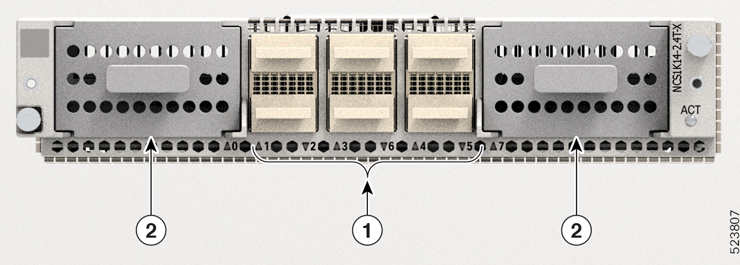Cisco NCS 1014 Chassis and Line Cards
The Cisco NCS 1014 chassis is an advanced multihaul optical platform supporting transponders and line system cards. It is a 2RU chassis that delivers a universal transponder solution which provides excellent performance for metro, long-haul and submarine applications.
Cisco NCS 1014 chassis has the following modules:
-
Removable controller
-
Removable backup solid state drive (SSD)
-
Two replaceable power supply units (PSU)
-
Three replaceable fan modules
-
Four line cards
In Release 7.11.1, the Cisco NCS 1014 chassis supports the line cards:
-
NCS1K14-2.4T-K9—2.4T DWDM Transponder Card
-
NCS1K14-CCMD-16-C/L—16-port Colorless Mux/Demux Optical Line Card
-
NCS1K4-1.2T-K9—1.2T DWDM Transponder Card
From Release 24.1.1, the Cisco NCS 1014 chassis supports the line cards:
-
NCS1K14-2.4T-X-K9—2.4T-X DWDM Transponder/Muxponder Card
-
NCS1K4-QXP-K9—3.2T QXP Transponder Card
1.2T Card
The 1.2T DWDM line card is a transponder that has 12 client ports to deliver 100GE and OTU4 client traffic. This line card has two trunks that operate at any rate between 100G and 600G in 50G increments. It uses Advanced Encryption Standard with a 256-bit key length (AES256)-based Layer-1 encryption to encrypt client-side data for 100GE and OTU4. The NCS1K4-1.2T-K9 line card is a single-slot unit that supports C-band traffic.
2.4T Line Card
The 2.4T line card is a coherent optics Transponder and Muxponder for the Cisco NCS 1014 chassis. It is a single-slot card that supports C-band traffic at trunk ports. This line card delivers 400GE, 100GE, and OTU4 client traffic over two trunk ports operating at speeds ranging from 400G to 1.2T each.
CCMD-16 Line Card
The CCMD-16 optical line card has:
-
Two line ports to transmit and receive using the same LC connectors.
-
16 ports for add/drop with LC connector-based interfaces
There are two variants of the optical line card:
-
NCS1K14-CCMD-16-C
The NCS1K14-CCMD-16-C line card is a C-band, 16-port Colorless Direct attach optical line card with EDFA. It can host up to 16 channels. It supports any signal distribution between 191250 and 196200 GHz, for example, the 64 channels grid with 75-GHz spacing.
-
NCS1K14-CCMD-16-L
The NCS1K14-CCMD-16-L line card is an L-band, 16-port Colorless Direct attach optical line card with EDFA. It can host up to 16 channels. It supports any signal distribution between 186025 and 191000 GHz, for example, the 64 channels grid with 75-GHz spacing.
2.4TX Line Card
|
Feature Name |
Release Information |
Feature Description |
|---|---|---|
|
NCS1K14-2.4T-X-K9 Line Card |
Cisco IOS XR Release 24.1.1 |
The new NCS1K14-2.4T-X-K9 line card is a single-slot Transponder and Muxponder card that delivers up to 1.2T C-band traffic at each trunk port. It has six QDD client ports that support 400GE and 4x100GE traffic on each port. This card provides two trunk ports that support 1.2T traffic on each port. The mxponder-slice and muxponder keywords in the hw-module command enable this card to operate in the following modes.
|
The 2.4TX line card is a coherent optics Transponder and Muxponder for the Cisco NCS 1014 chassis. It is a single-slot card that supports C-band traffic at trunk ports. This card delivers 400GE and100GE client traffic over two trunk ports operating at speeds ranging from 400G to 1.2T each. This card operates in two card modes, namely, the muxponder mode and the muxponder slice mode. In muxponder mode, the client traffic splits between the two trunk ports for 600G and 1000G payloads on port 2 and 3 respectively. In this mode, both trunk ports always carry the same data rate. In muxponder slice mode, both trunk ports act independently, carrying different data rates in each trunk.
 Note |
In Release 24.1.1, the 2.4TX line card supports only 400, 500, 600, 800, 1000, and 1200G trunk payloads. |
For more information about the 2.4TX card, see datasheet.
In the 2.4TX card, the client and trunk ports support the pluggable form factor and data rates as shown in the following table.
|
Interfaces |
Form Factor |
Ports |
Data Rates |
|---|---|---|---|
|
Client |
QSFP-DD56 |
1, 2, 3, 4, 5, 6 |
400G |
|
QSFP-DD112 |
2, 5 |
400, 800G |
|
|
Trunk |
Coherent Interface Module 8 (CIM8) |
0, 7 |
up to 1.2T in each port |
 Note |
In Release 24.1.1, the ports 2 and 5 support only up to 400G data rates. |
The 2.4TX card has two trunk ports and six client ports as shown in the following figure.

|
Callout |
Interface |
|---|---|
|
1 |
Client port |
|
2 |
Trunk port |
The following figure shows the mapping between the client and trunk ports.

|
Trunk Port |
Client Ports |
|---|---|
|
0 |
1, 2, 3 |
|
7 |
4, 5, 6 |
 Note |
This client-to-trunk port mapping is only applicable for the mxponder-slice mode. |
QXP-K9 Line Card
The QXP-K9 line card is a high-density QSFP-DD transponder that has eight client ports (QSFP-DD) and eight trunk ports (QSFP-DD ZR+). It is a single-slot card that supports 3.2T traffic through its eight QSFP-DD trunk ports. Each trunk port operates at speed up to 400G in a 50G increment. Each client port supports 400GE, 4x100GE, and 100GE without FEC client rates.
 Feedback
Feedback